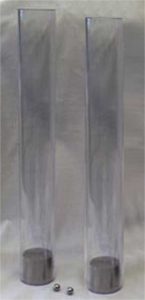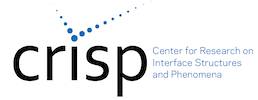Our kits are currently being reviewed and updated by a team of collaborative, innovative and interdisciplinary educators who wish to enhance the educational opportunities for students. These dedicated teachers are members of CRISP Collaborative Science for All (CCSA) as well as local educators.
Click to see the SCSU CRISP Module Template used by CCSA for improving and updating the CRISP demos and kits. Each kit page offers a CRISP developed teacher module and CRISP aligned standards (both NGSS and CCSS)
Kit Request form

An amorphous metal (metallic glass or glassy metal) is a solid metallic material, usually an alloy, with a disordered atomic-scale structure. Most metals are crystalline in their solid state, which means they have a highly ordered arrangement of atoms.
Adapted from Atomic Trampoline by the University of Madison Wisconsin MRSEC
Subject(s):
Amorphous metals, Properties of materials, Mechanics
Objectives:
Students will understand the way different materials react in the same situations as well as the practical applications for amorphous metals.
Materials in this kit:
- 1 stainless steel base
- 1 stainless steel base with a 1/8 inch thick disk of Liquidmetal® (Zr41.2Be22.5Ti13.8Cu12.5Ni10.0) glued to it
- 2 clear plastic tubes which slide over the top of the bases
- 2 hardened steel ball bearings
- Booklet complete with pictures and figures which help explain the behavior of the amorphous metal, as well as some other activities to try with the demonstration set-up
Suggestions for the Teacher:
Safety:
- Liquidmetal® contains zirconium, copper, titanium, nickel and beryllium. Several of these elements are highly toxic. Although the disks are perfectly safe and can be handled without special precautions, do not polish, sand, scratch, file, or chip the Liquidmetal® disk. This will ensure that particles of the alloy do not come in contact with skin and cannot be ingested.
Additional Resources:
Atomic Trampoline teacher module
Atomic Trampoline Guide
Trampoline CRISP aligned standards
STEM Careers:
Material scientist
Biochemical engineer
Chemist
Researcher
Engineer
Industrial Engineer
Materials Engineer
Nanotechnologist
Standards:
MS-PS1-1 Matter and its Interactions
Develop models to describe the atomic composition of simple molecules and extended structures.
HS-PS1-3 Matter and its Interactions
Plan and conduct an investigation to gather evidence to compare the structure of substances at the bulk scale to infer the strength of electrical forces between particles
MS - PS1.A: Structure and Properties of Matter
- Substances are made from different types of atoms, which combine with one another in various ways. Atoms form molecules that range in size from two to thousands of atoms.
- Solids may be formed from molecules, or they may be extended structures with repeating sub-units (e.g., crystals).
HS-PS1.A: Structure and Properties of Matter
- The structure and interactions of matter at the bulk scale are determined by electrical forces within and between atoms.
MS CC 3 - Scale, Proportion, and Quantity
- Time, space, and energy phenomena can be observed at various scales using models to study systems that are too large or too small.
HS CC1 - Patterns
- Different patterns may be observed at each of the scales at which a system is studied and can provide evidence for causality in explanations of phenomena.
MS SEP 2 – Developing and Using Models
- Develop a model to predict and/or describe phenomena.
HS SEP 3 – Planning and Carrying out an investigation
- Plan and conduct an investigation individually and collaboratively to produce data to serve as the basis for evidence, and in the design: decide on types, how much, and accuracy of data needed to produce reliable measurements and consider limitations on the precision of the data (e.g., number of trials, cost, risk, time), and refine the design accordingly.
